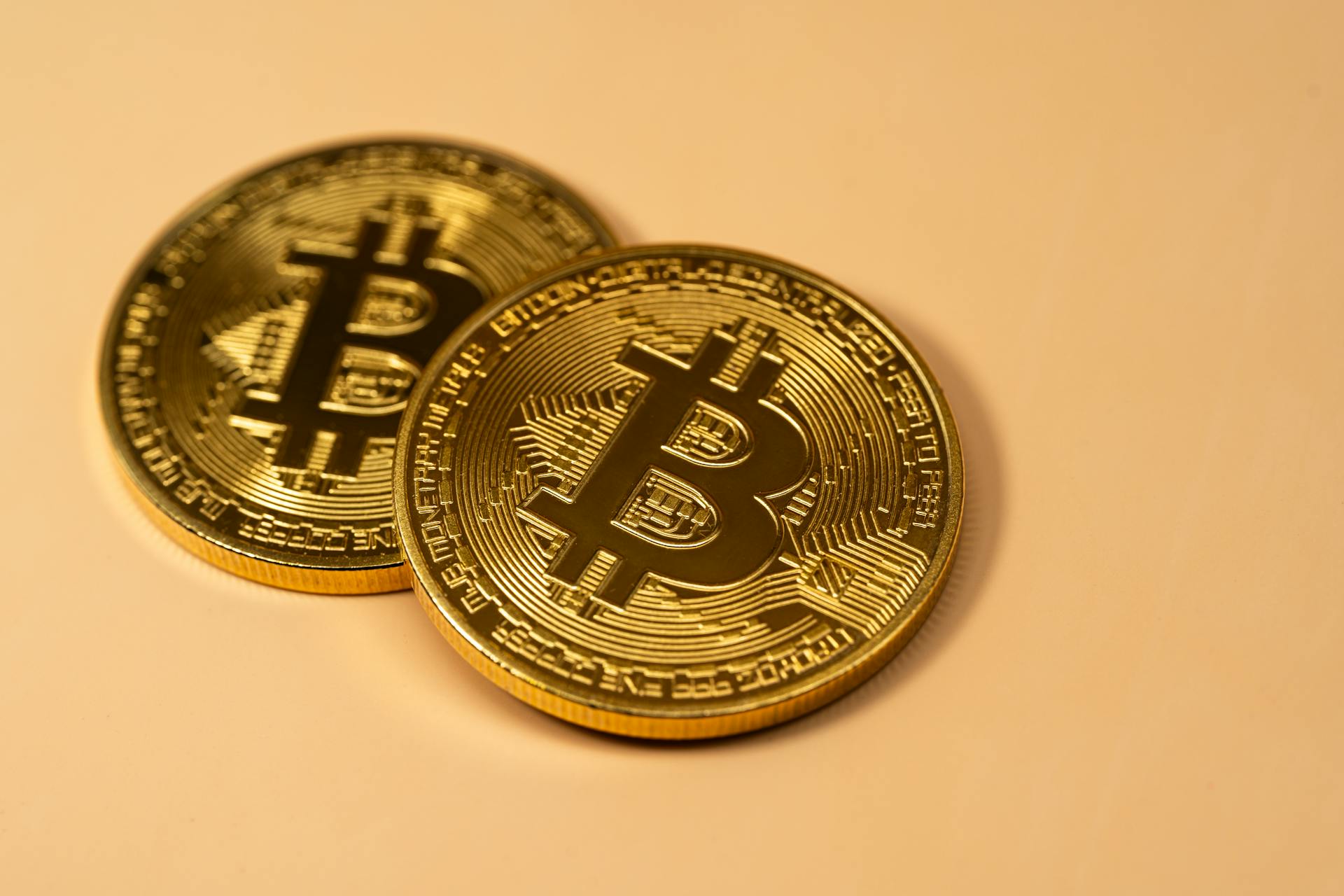
Blockchain database storage offers a decentralized and secure way to manage data. This new paradigm is built on the principles of blockchain technology, which allows for a distributed and immutable ledger.
Traditional databases can be vulnerable to data breaches and single-point failures. Blockchain database storage eliminates these risks by spreading data across a network of nodes.
The decentralized nature of blockchain database storage makes it ideal for applications that require high data integrity and security. This is particularly important for industries like finance and healthcare, where sensitive information is often stored.
A key feature of blockchain database storage is its ability to provide a tamper-proof record of all data transactions. This is made possible by the use of cryptographic techniques and a consensus mechanism that ensures all nodes on the network agree on the state of the data.
Explore further: Users Retrieve Data Stored
What is Blockchain Database Storage?
A blockchain database is a decentralized digital ledger of transactions maintained by a network of computers.
It's like a digital notebook that many people can write in, but no single person controls it. Each block in the chain contains a record of multiple database transactions.
This creates a continuous, unbroken chain of information that's linked together. Any changes to a transaction would need to be approved by the entire blockchain network.
Because blockchain databases are decentralized and encrypted, they're often used for secure and transparent record-keeping in industries like finance, healthcare, and supply chain management.
For example, cryptocurrencies like Bitcoin use blockchain technology as the foundation of their transaction systems.
However, blockchain networks often experience slow confirmation times and high transaction fees due to the blockchain bottleneck, which limits the number of transactions that can be processed at one time.
Suggestion: Bnb Smart Chain Bep20 Bitpay
Traditional Models vs Blockchain
Traditional models of data storage, such as centralized databases, rely on a single entity to control and manage data. This creates a single point of attack, making it vulnerable to tampering or hacking.
Take a look at this: Ethereum Data Dashboard
Decentralized blockchain databases, on the other hand, distribute data across a network of computers, making it more resistant to tampering or hacking. This is because blockchain is maintained across an entire network of computers, distributing attack points and risk.
In contrast to traditional storage, blockchain databases use cryptography to secure data, making it more difficult for attackers to tamper with or steal data. This is a more secure way to store information and sensitive data such as financial or medical records.
Here are some key differences between traditional models and blockchain:
By choosing a blockchain database, you can take advantage of its built-in security features, such as immutability and cryptography, which provide a higher level of security and trust compared to traditional databases.
Traditional Models
Traditional databases are centralized, meaning they're controlled by a single entity, such as a government or corporation, which represents a single point of attack.
Centralized databases can be vulnerable to tampering or hacking, unlike blockchain databases that are maintained across an entire network of computers.
Traditional databases rely on access controls and other security measures, leaving data less secure compared to blockchain-based databases that use cryptography.
In traditional storage, data can be designed to limit access to any specific data or transactions, unlike blockchain databases that are transparent by design.
Traditional databases don't require a consensus mechanism to validate transactions and add them to the database, unlike blockchain databases that rely on a consensus mechanism to validate transactions.
The regulatory environment around traditional databases is well-established, with clear laws and regulations in place, unlike blockchain-based systems that are still developing and creating legal and compliance risks.
For projects that demand compliance with existing laws and regulations, a traditional database may be preferable due to the regulatory certainty it provides.
Expand your knowledge: Hipaa Data Storage Requirements
Validate the
Validate the data on a blockchain is crucial to ensure its accuracy and reliability. Consensus mechanisms, like Proof of Work (PoW) or Proof of Stake (PoS), ensure that the network validates and verifies the data.
Intriguing read: Ether Proof of Stake Date
In traditional models, data validation is often a manual process that can be time-consuming and prone to errors. In contrast, blockchain's decentralized nature and cryptographic encryption make it a more secure way to store information.
Consensus mechanisms, such as those used in blockchain, ensure data integrity and consistency across the network. This is particularly important in industries where trust is at a premium, such as finance and healthcare.
Here are some key benefits of data validation on a blockchain:
- Ensures data integrity and consistency across the network
- Verifies the accuracy of uploaded data
- Prevents fraudulent alterations and inconsistencies
By validating data on a blockchain, you can increase trust among users and ensure the accuracy and reliability of the data stored on the network. This is especially important in industries where data integrity is critical, such as finance and healthcare.
Challenges and Limitations
Blockchain storage offers numerous benefits, but it's not without its challenges. Scalability is one of the main limitations, making it difficult to handle a large volume of transactions.
Using layer 2 solutions like sidechains and sharding can improve transaction throughput, addressing scalability concerns. This approach allows for more efficient processing of transactions, making blockchain storage more viable.
Energy consumption is another limitation, as traditional consensus mechanisms can be energy-intensive. Implementing energy-efficient consensus mechanisms like Proof of Stake (PoS) can significantly reduce energy consumption.
Data privacy concerns are also a major limitation, as blockchain storage is a public ledger. Using zero-knowledge proofs (ZKPs) and private blockchains like Hyperledger can provide better confidentiality and protect sensitive information.
Here are the main challenges and their potential solutions:
Creating a Blockchain Database
Creating a blockchain database involves several complex steps. First, you need to determine the specific purpose and requirements of the database, including the type of data to be stored and the level of security required.
Identify the type of data to be stored, such as user information, financial transactions, or medical records. This will help you choose the right blockchain platform.
Choose a blockchain platform like Ethereum, Hyperledger, or Corda, each with unique features that suit different needs. Some platforms are more suitable for enterprise use, while others are ideal for decentralized applications.
Define the data schema by specifying the structure and format of the data, including data types, fields, and relationships between data. This will ensure that the data is organized and easily accessible.
Develop a smart contract to control the database, which is a self-executing program that runs on the blockchain platform. The smart contract defines the rules and logic for accessing and modifying the data in the database.
Deploy the database on the blockchain platform once the smart contract has been developed, creating a decentralized database that network users can access and modify. This step is crucial for ensuring data security and integrity.
Test the database thoroughly to ensure it functions correctly and meets all your requirements. Ongoing maintenance is essential to ensuring the security and integrity of the database over time.
Storage Methods and Considerations
Storing data on the blockchain requires careful consideration of the type and size of the data. This decision is crucial as it helps decide whether to store the data on-chain (for small data like text or metadata) or off-chain (for larger files or media).
On-chain data is limited to small data, such as text, metadata, or small transaction details, while off-chain data can store large files, media, and documents. Assessing the size and type of your data will help you decide whether to use the blockchain directly or opt for external storage solutions.
To choose the right blockchain storage method, consider the following factors:
- Type of Data: Decide whether your data is small (text, smart contracts) or large (files, media).
- Privacy Needs: Determine if your data requires public transparency or needs to be kept private.
- Cost Implications: On-chain storage often involves transaction fees and server costs, while off-chain storage solutions (such as IPFS) may have subscription models or server fees.
Are Used for?
Databases are used for storing a lot of data, which is critical for blockchains and DLTs that need to store data for a long period of time.
The right NoSQL database can enable these applications to scale their data very easily, as seen in IOTA's supply chain digitization initiative.
Distributed Ledger Transactions (DLTs) like the Tangle data structure can store data in a scalable way by using a directed acyclic graph (DAG) structure.
This structure allows new transactions to be attached anywhere in the Tangle, drastically reducing the limit on confirmation times.
The Tangle is secured by a temporary finality device called the Coordinator, which decides which parts of the Tangle are valid and should be confirmed.
In a fully decentralized Tangle, the Coordinator will be removed, making the Tangle completely decentralized.
Recommended read: Store Firearms
Types of
There are several types of blockchain databases, including public blockchains, private blockchains, consortium blockchains, hybrid blockchains, sidechains, and federated blockchains.
Public blockchains are open to anyone and are not controlled by a central authority, examples include Bitcoin and Ethereum.
Private blockchains store data in blocks that are permissioned, so only authorized users can access and participate in the network, often used by businesses and organizations for internal record-keeping and transactions.
Consortium blockchains are similar to private blockchains, but they are operated by a group of organizations rather than a single entity.
Hybrid blockchains combine elements of public and private blockchains, allowing for greater flexibility in terms of access and participation.
Sidechains are separate blockchains that connect to the main blockchain, allowing for the creation of new applications and services that can interact with the main blockchain.
Federated blockchains are similar to consortium blockchains, but they are controlled by a group of independent organizations rather than a single entity.
A blockchain graph database combines the features of blockchain technology and graph databases, storing data in the form of nodes and edges, allowing for more complex relationships between data to be modeled and queried.
A blockchain relational database combines the features of traditional relational databases and blockchain technology, storing data in tables with predefined relationships, but also using blockchain technology to ensure the integrity and security of the data.
Some blockchain databases may not be suitable for high scalability and fast processing demands, in which case a traditional database may be a better option.
Here are some key differences between types of blockchain databases:
ScyllaDB Solutions
ScyllaDB Solutions are perfect for data-intensive blockchain applications that require speed, scale, and efficiency. They offer a unique blend of these qualities, making them ideal for cloud or on-premise use.
ScyllaDB's flexible NoSQL data modeling allows for a wide range of data structures, making it a great choice for applications with varying data needs. This flexibility is especially useful for blockchain applications that often involve complex data relationships.
Related reading: How to Develop Blockchain Applications
ScyllaDB solutions also provide fault tolerance, which is crucial for applications that require high uptime and reliability. This means that even in the event of a failure, ScyllaDB can recover quickly and minimize downtime.
ScyllaDB's ability to handle large amounts of data makes it a great choice for blockchain applications that involve massive amounts of data storage. This is especially important for applications that require fast data retrieval and processing.
Recommended read: Applications for Blockchain Technology
Storage Methods
There are two primary methods for storing data on blockchain: on-chain storage and off-chain storage. On-chain storage directly stores small, critical data like metadata, transaction details, or smart contract variables on the blockchain. It ensures security, transparency, and immutability through the decentralized network.
The key pros and cons of on-chain data storage include:
Off-chain storage, on the other hand, stores data outside the blockchain while maintaining a reference to it on the blockchain. This method is suitable for large datasets, which would be impractical to store directly on the blockchain. Off-chain storage solutions like IPFS, Filecoin, and Arweave provide decentralized options for securely storing data off-chain while maintaining the benefits of blockchain technology.
The choice between on-chain and off-chain storage depends on the size and nature of the data being stored. If the data is small and critical, on-chain storage is a good option. However, if the data is large or complex, off-chain storage is a better choice.
Latency
Latency is a significant issue hindering the adoption of certain storage methods today. Regular transactions using databases and code are currently faster than utilization of the blockchain.
Transactions on traditional systems can process data in a matter of milliseconds, while blockchain technology often takes seconds or even minutes to complete. This is a major drawback for applications that require fast data processing.
The slow speed of blockchain technology can be frustrating for users who are accustomed to quick results. It's a challenge that developers are working to overcome, but for now, it's a limitation of this storage method.
As a result, some applications may not be suitable for blockchain technology due to its slow processing time. This is something to consider when evaluating storage options for your project or business.
Frequently Asked Questions
How much data can be stored in a blockchain block?
Blockchain blocks can store a small to moderate amount of data, typically ranging from megabytes (MB) to a few gigabytes (GB), depending on the specific blockchain. This limited storage capacity is one reason why blockchains are often used for storing metadata rather than large files.
Sources
- https://www.scylladb.com/glossary/blockchain-database/
- https://www.snia.org/education/what-is-blockchain-storage
- https://www.upgrad.com/blog/how-to-use-blockchain-to-store-data/
- https://medium.com/@cedalio/blockchain-data-storage-dilemma-on-chain-vs-off-chain-b1d56e3881c2
- https://ethereum.stackexchange.com/questions/11987/how-does-data-storage-on-the-blockchain-work
Featured Images: pexels.com


